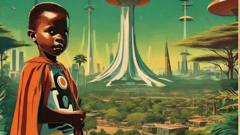In the heart of Kenya, Nairobi is often referred to as “the green city in the sun,” a title that depends heavily on the observer's perspective. While residents of upscale neighborhoods may revel in this title, the reality is starkly different for those living in the city’s slums, where poverty and ecological challenges manifest in severe flooding and destructive landslides.
To introduce a sense of hope and transformation, the art collective Kairos Futura is spearheading an exhibition titled Hakuna Utopia. This showcases the works of seven artists who delve into themes of resilience and the apocalypse, capturing the daily struggles of Nairobi’s six million residents in captivating, abstract forms.
Stoneface Bombaa, a member of the collective and a proud Mathare local, is driven by the need to tell the story of his community, a place often overshadowed by lack of opportunities and basic necessities. He describes a "hand-to-mouth economy," where uncertainty looms over each meal. However, through his artwork, Bombaa aims to rechannel the community's frustrations into unity and positivity, emphasizing the unifying power of art. His ambition led him to create "micro-utopia" sites within the city, although his vision faced challenges when one of his identified locations was demolished for new infrastructure.
Undeterred by obstacles, Bombaa has taken the initiative to expose children from Mathare to the beauty of Nairobi’s parks and green spaces—something that is largely absent in their own neighborhood. His vision of a utopia involves everyone in his community having unrestricted access to nature, which he believes is their right, regardless of economic standing.
Inspired by the intricate structures of termite mounds, fellow artist Coltrane McDowell creatively reimagines the future of architecture in his work, Invisible Cities, while Abdul Rop brings forth a message of collective action. Recognized for his striking woodcut prints and paintings, Rop believes that to create a utopian future, Nairobians must work together, particularly the youth, who have recently taken to the streets demanding change in response to a corrupt political climate.
Rop suggests that engaging with the concept of utopia through art can empower young people to think creatively about their futures. "The moment to act for the future is now," he asserts, implying that their artistic endeavors may be the key to unlocking a more robust, equitable future.
Other artists, such as Ajax Axe, also contribute by transforming mundane objects like school chairs, making them more engaging and reflective of the exhibition’s hopeful vision. Through creative expression, Kairos Futura illuminates pathways for Nairobians—not only to imagine a better tomorrow but to empower them to collectively push for the change they desire today.



















